 |
Well, we took a bit of a shortcut with the facts in the preceding sections in underplaying this structure. We know that certain bacteria can invade our cells and multiply there, even using our actin as cords to move around. That makes us sick. But what if that bacteria had something to offer? Would our cells strike a deal? Pure speculation, but mitochondria have so many similarities to bacteria it is very hard not to notice.
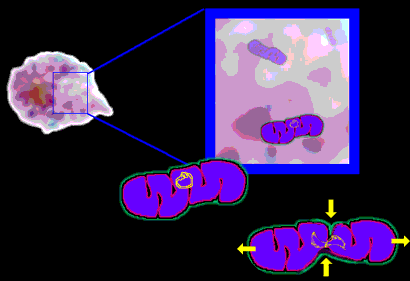 They are small and built like bacteria having their
own outer membrane. They have their own DNA. That DNA forms a ring, as we find in bacteria. Mitochondria divide much as do bacteria, by growth and pinching off into two parts - each getting copies of the DNA.
They are small and built like bacteria having their
own outer membrane. They have their own DNA. That DNA forms a ring, as we find in bacteria. Mitochondria divide much as do bacteria, by growth and pinching off into two parts - each getting copies of the DNA.
That settles it? Well ... they are common to cells of all but the most primitive sort right across the animal kingdom. They do seem a bit like chloroplasts running in reverse - but just a bit. Whatever.
The association of mitochondria with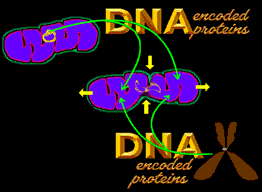 animal cells is long and profound - for both. Whatever they were once, they rely on the host cell for MOST of their protein code as the cell nucleus
transcribes quite a bit more than half the code which mitochondria use in their structure. However, it is noteworthy that the central key oxidation processes are coded by that of the mitochondria.
animal cells is long and profound - for both. Whatever they were once, they rely on the host cell for MOST of their protein code as the cell nucleus
transcribes quite a bit more than half the code which mitochondria use in their structure. However, it is noteworthy that the central key oxidation processes are coded by that of the mitochondria.
As each mitochondrion has several copies of its own DNA and as there are many mitochondria in any given cell, a mutation of DNA may not fully manifest on the involved mitochondrion and many others probably are not affected at all. Mitochondria have their own ribosomes (particles that are made of RNA and are essentially machines that read genetic code and build proteins from amino acid sequences strung together).
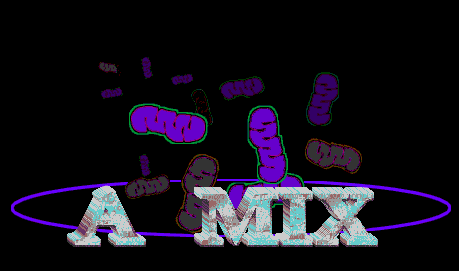 |
Disorders of mitochondria involve mixtures involved and uninvolved organelles. It is a question of percentages. Sometimes, even 20% normal and 80% abnormal will not get noticed as the 20% pick up the pace - they work on demand. However, age accumulates mutations in mitochondrial DNA - that is part of what aging actually is. Ready for this? You CAN prevent aging. Just don't eat and don't breathe. Hmmm. The metabolic waste of the oxidative process is the major contamination that mutates the mitochondrial DNA. Anyway, add that sequential loss to an 80% defective starting point and you get early adult onset disease. This is another way genetic disorder can manifest late - genetic mixture. We use up what's working.
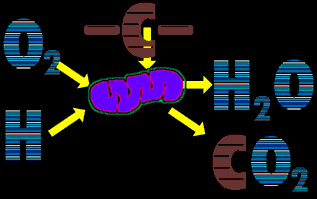
This is the bottom line of what these intracellular critters do. The cell can get energy from glucose down to splitting that 6 carbon structure in half - sucking up some of the energy then disposing the two fragments (3 carbons each). The mitochondria essentially burn this waste by incredible nit picking at electrons and hydrogen protons.
Rather than flame, from this they generate a cell wide energy source called ATP -fuel packets- like little batteries that can drive all sorts of protein machines to do improbable things. They can reverse, a bit, as well to assist the inter conversion of substances. Carbohydrates, amino acids, fats - the conversion between them requires the mitochondria.
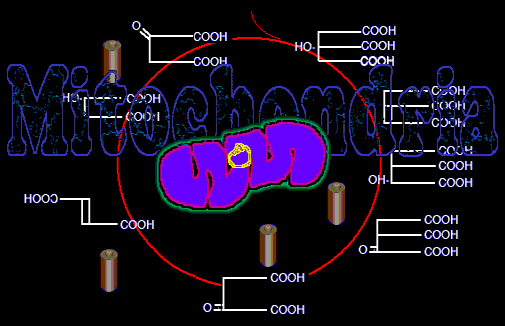 This is where the citric acid cycle
lives. Pyruvate, a three carbon left
over from splitting glucose, enters the mitochondrion and is converted to
This is where the citric acid cycle
lives. Pyruvate, a three carbon left
over from splitting glucose, enters the mitochondrion and is converted to
Acetyl Coenzyme-A (AcCoA) by whacking off one carbon (=>CO2).
A process of stealing electrons and hydrogen begins. Electron and proton lugging molecules (certain
vitamins) are employed which are welded onto RNA (see NAD also a variant called FAD, a flavin version) and thus passed around. The process is set up like a bucket
brigade - one which buckets the hydrogen and electrons stripped from the carbon source driven by the linked oxidation. It is burning, except the flame - the heat - is trapped into ATP energy batteries.
As mitochondria are many and get split up with cell division and as only the egg has significant cytoplasm and the sperm little - mitochondria of children ALL COME FROM THE MOTHER. Diseases of mitochondria will be most evident in those organs with high oxidation needs.
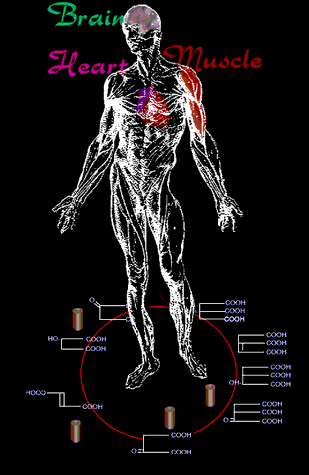 The organs of greatest oxidative intensity are brain, heart and
muscle. In the mitochondrial disorders we find serious neurologic disorders, cardiomyopathies (sick heart muscle), and muscle diseases (dystrophies if you prefer).
The organs of greatest oxidative intensity are brain, heart and
muscle. In the mitochondrial disorders we find serious neurologic disorders, cardiomyopathies (sick heart muscle), and muscle diseases (dystrophies if you prefer).
Of muscles, those affected most are those with higher aerobic metabolism (red meat) versus those which are more apt to just use the anaerobic short cut (white meat) and let the liver recycle the lactate. Because inner eye muscles are very oxidative, weakness is given away by the eyes drifting outward - exophoria, (o ) ( o) , alias external opthalmoplegia.
Blood (arterial blood especially) may have too much lactate compared to pyruvate - a clue that the pyruvate can't get into the oxidative cycle. However, due to the mix, that excess created by some mitochondria may well be siphoned of and unseen.
The lab folks, armed with new tools (thank you Perkin Elmer etc), are going right for the direct assay of DNA and specific proteins. The best way to test is changing nearly day to day. What do pediatric orthopedists do? We punt to the medical folks.
Symptoms (What patient experiences) & Signs (What others see)
From the following list, take one or more entries in nearly any combination and there is a mitochondrial disorder that fits: The clinical differentiation almost fails at the outset as there is so much overlap. The diseases are no longer being grouped by symptom-sign clusters, but by molecular pathology. Given the wide array of "mixture" phenomenon (what % of involvement) the disorders are difficult to define even when named by cause.
Ataxia - wobbly hesitant gait, mis-stepping
Speech - deep and hollow sounding, with loss of usual content related rhythm, hops and stops
Dystonia - high muscular tone inappropriate to function and amplified by sensory input
Choreoathetosis - a fine winding, almost twitchy movement superimposed on regular movement
Seizure
Stroke (young)
Wall eye, diverging eyes
Twitching eye balls - jiggling in short horizontal jumps (nystagmus)
Acidosis (lactic)
Myopathy (weak and degenerative muscle)
Cardiomyopathy (heart muscle degeneration)
Diabetes
Gastrointestinal disorders
Neuropathy - loss of peripheral nerve function (especially if sensory loss and distal, eg: - vibration)
Blindness
Retinal Pigmentation
Hearing Loss
Anemia (low blood count)
Loss of Intellect
Fatigue
Muscle aches
Hypotonia
more..
Some names :
MELAS (Mitochondrial Encephalopathy Lactic Acidosis Stroke)
Leber's Hereditary Optic Neuropathy
Retinitis Pigmentosa
Progressive External Opthalmoplegia
Mitochondrial Myopathies (a variety of sub types)
Friedreich's Ataxia
Cerebellar Ataxia
Huntington's Chorea
Spastic Paraparesis
Wilson's Disease
(various) Neuropathies
more..
Remember, that even though many of the above will have gene abnormalities on one chromosome or another, the gene may be read and transcribed by and/or for the mitochondrion. Diagnosis generally falls to the geneticist, neuro-geneticist, neurologist, or biochemical metabolism expert. The job of pediatric orthopedics is the same in this arena as in all the others, trying to maintain the big 3:
Life, liberty, and the pursuit of happiness.
It isn't always possible.